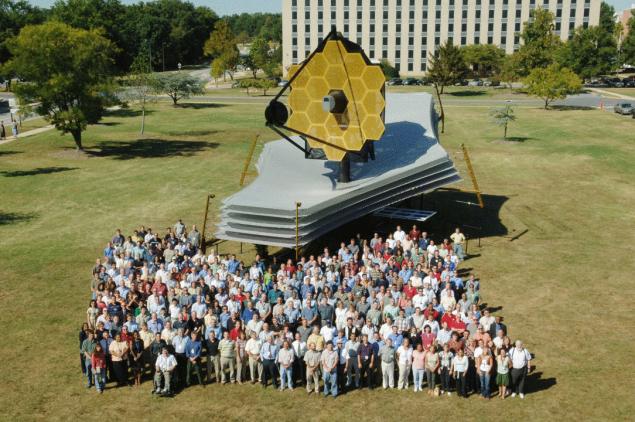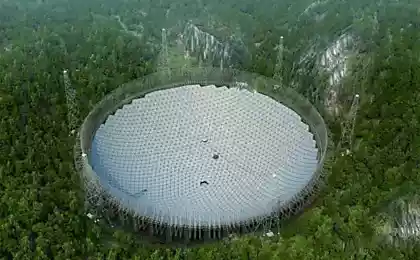656
How will the space telescope James Webb

Our knowledge about the Universe is restricted by the limits of our senses, but our minds know no such limits. When the light of the fire blinds us in the wooded darkness, we imagine all sorts of terrible prospects. But if you take a few steps and leave the fire behind, we see more deeply and clearly. Imagination meets with info and we suddenly realize what we're dealing with.
If it were always that easy. To embrace the Universe and to understand the space, you need more than a pair of eyes and the distance from the lights of the city. The necessary tools that extend our senses beyond our evolutionary limits, our atmosphere or even planetary orbit. Astronomy and cosmology are limited and disadvantaged by the quality of such tools. 400 years ago the first telescope suddenly revealed unexpected moon, planets and sunspots, which gave rise to the continuity of cosmic theories led to more advanced tools that reveal billowing nebula and collecting stars on the way.
In the mid-20th century, radio telescopes have revealed that galaxy is not static, drop, and active and tireless energy. To the space telescope Kepler, we thought that extrasolar planets are rare in the Universe; now we suspect that there may be more than the stars. Two decades in earth orbit the Hubble space telescope has helped us to break through the veil of time, demonstrating stellar nurseries and prove that galaxies collide. Now the space telescope James Webb is going to become back to the sunlight, to take a step off the Ground and allow us to observe the cold and dark space behind the Moon.
The launch of the Webb is scheduled for 2018, and its construction involved 14 countries. The telescope needs to answer some very ambitious questions. When a powerful telescope will be launched along with the rocket European space Agency Ariane 5 ECA, it will mark a new wave of development of ground and space-based instruments, including several new observatories in Hawaii and Chile.
If the telescope will survive launch and your journey of 1.5 million kilometers from Earth at the second Lagrange point (L2) is one of five locations in the system Earth-Sun, where gravity will naturally hold the spacecraft in place — it will take astronomers closer to the beginning of time and will show glimpses of sights that have long been considered a hypothetical, but which has not been seen: from the birth of galaxies to light of the first stars.
Mission: standing on the shoulders of giants

The mission of the Webb relies entirely on the work of the Great observatories NASA's four great telescopes, whose instruments cover the entire electromagnetic spectrum. Four overlapping each other mission has allowed scientists to observe the same astronomical objects in the visible, gamma-ray, x-ray and infrared spectra.
Hubble is the size of the bus, sees the first visible region of the spectrum and a little ultraviolet and infrared. His program began in 1990 and through the continued support will last long enough to pass the baton to Webb. Named after Edwin Hubble, the astronomer who discovered many problems to explore this telescope, he became one of the most productive scientific instruments in history, giving us phenomena like the birth of a star and its death, the evolution of galaxies and black holes (from the theory to the observed facts).
With Hubble in the big four includes the Compton gamma ray Observatory (CGRO), x-ray Observatory "Chandra" space telescope and Spitzer.
CGRO, launched in 1991, no longer serviced, has detected high-energy ill effects from 30 kiloelectron-volts (Kev) to 30 gigaelectron-volts (GeV) including the energy of the eruption of active galactic nuclei.
Chandra, launched in 1999 and still remain afloat, watching black holes, quasars and high-temperature gas in the x-ray spectrum, and provides important data about the birth, growth and ultimate fate of the Universe.
Spitzer, who occupied the orbit of the passing of the Earth, exploring the sky in the thermal infrared (3-180 microns) range, watching the birth of stars, galactic centers and cool dim stars. Also he is looking for certain molecules in space.
Webb will peer into the near and middle infrared spectrum, which will contribute to his position in the L2 point behind the moon and sun shields, which block the Intrusive light of the Sun, Earth and moon, favorably affecting the cooling apparatus. Scientists hope to see the first stars of the Universe, the formation and collision of young galaxies, birth of stars in protoplanetary systems which may contain chemical components of life.
These first stars may hold the key to understanding the structure of the Universe. Theoretically, where and how they are formed, directly connected with the first models of dark matter — the mysterious invisible subscale, which detect by its gravitational influence — and their cycles of life and death cause feedback that influenced the formation of the first galaxies. And since supermassive stars with short period of life is about 30-300 times heavier than our Sun in mass (and millions of times brighter), these first stars could explode in a supernova, and then collapse and form black holes, which gradually occupied the centers of most massive galaxies.
See it all — of course, the feat tool, which we have done so far. Thanks to new instruments and spacecraft, we will be able to see more of that.
A tour of the space telescope James Webb

Webb looks like a diamond-shaped raft, equipped with a thick curved mast and sail — if it was built by the giant bees that feed on beryllium. Toward the lower part of the Sun, below the "raft" consists of a shield layer of Kapton separated by gaps. Each layer separated by a vacuum gap for effective cooling, and together they protect the main reflector and tools.
Kapton is very thin (think human hair) polymer film production DuPont, which is able to maintain a stable mechanical properties under extreme heat and vibration. If you want, you can boil water on one side of the shield and keep nitrogen in a liquid state on the other. Develops it is also quite good, which is important for launch.
Ship "Kiel" consists of a structure that stores solar shield during launch and solar panels to provide power for the apparatus. In the center is a box that contains all the important functions of support, which works Webb, including power, attitude control, communications, command, data handling, and thermal control. Antenna adorns the exterior of the box and helps to make sure that everything is focused in the right direction. At one end of the heat shield, perpendicularly thereto, is a trimmer point, which compensates for the pressure exerted by the photons on the device.
On the outer side of the shield is "sail", a giant mirror Webb, part of the optical equipment and the box with the equipment. 18 hexagonal beryllium sections will unfold after launch to become one large primary mirror 6.5 meters in diameter.
In front of this mirror, held in place by three pillars, is a secondary mirror, which focuses the light from the main mirror in the aft optical subsystem, wedge-shaped box extending out of the center of the primary mirror. This structure deflects the scattered light and directs the light from the secondary mirror to the instruments placed in the rear part of the mast, which also supports the structure of the segmented primary mirror.
After the machine completes its six-month period of commissioning, it will last 5-10 years, maybe more, depending on fuel consumption, but its location is too far to be repaired. In fact, Hubble and the international space station are kind of exceptions in this regard. But as Hubble and other observatories, mission, Webb will work with the project scientists around the world, selected on a competitive basis. Then the results will find their way in the research and data available on the Internet.
Let's take a closer look at the tools that make these studies possible.
Tools: beyond the field of view

Although he sees something in the visual range (red and gold light), Webb is fundamentally a large infrared telescope.
Its primary imager, the near infrared camera NIRCam spectrum, sees the range of 0.6-5.0 microns (near infrared). It can detect infrared light of the birth of the first stars and galaxies, to conduct surveys of nearby galaxies and the local objects, scurrying through the Kuiper belt — the icy expanses of bodies, revolving beyond the orbit of Neptune, which also fit Pluto and other dwarf planets.
NIRCam is also equipped with a coronagraph, which will allow the camera to observe a thin halo surrounding bright stars, blocking their blinding light is an essential tool for the detection of exoplanets.
The near infrared spectrograph NIRSpec operates in the same wavelength range, and NIRCam. Like other spectrographs, it analyzes the physical properties of objects of type star, separating the emitted light into spectra, the structure of which varies with temperature, mass and chemical composition of the object.
NIRSpec will study thousands of ancient galaxies with weaker emission, a spectrograph will need hundreds of hours to this work. To simplify this difficult task, the spectrograph is equipped with a wonderful device: the grid, out of 62,000 individual shutters, each measuring approximately 100 by 200 microns (the width of several human hairs) and each of which can be opened and closed, blocking the light more bright stars. Thanks to this array, NIRSpec will be the first spectrograph in space that can observe hundreds of different objects simultaneously.
Fine Guidance Sensor and bessellieu spectrograph (FGS-NIRISS) is, in fact, two sensors packaged together. NIRISS incorporates four modes, each associated with a different wavelength. They range from bessellieu spectroscopy, which produces a spectrum using a prism and grating called "Prisma", all of which create a interference pattern that can identify ekzoplanetoy light on the background of star light.
The FGS is a sensitive and unblinking camera, which makes navigation images and transmits them to the attitude control system, which keep the telescope in the right direction.
The latest tool Webb expands the range of from near infrared to medium infrared spectrum, which is useful for observation of objects with redshift, as well as planets, comets, asteroids, the sun-warmed dust and protoplanetary disks. As a camera and a spectrograph at the same time, the MIRI instrument covers a wide wavelength range, 5-28 microns. Its broadband camera will be able to do more types of shots that we love Hubble.
Infrared observations are important for understanding of the Universe. Dust and gas can block the visible light of stars in stellar nurseries, but infrared is not. Moreover, with the expansion of the Universe and the recession of galaxies, their light is "stretched" and becomes red shift, moving away in the wavelength range of electromagnetic waves like infrared. The more distant a galaxy, the faster it is removed, and the more important its red shift — that is the value of the Webb telescope.
The infrared spectrum can also provide a large amount of information about the atmospheres of exoplanets and whether they are molecular components associated with life. On Earth we call water vapor, methane and carbon dioxide "greenhouse gases" because they absorb heat. Since this trend is fair everywhere, scientists can use Webb for detection of familiar substances in the atmospheres of distant worlds, watching the patterns of absorption of substances with the help of spectrographs.
Source: hi-news.ru
Juice in the morning increases blood pressure
The award "Educator" — the main Russian-language non-fiction books of the year























